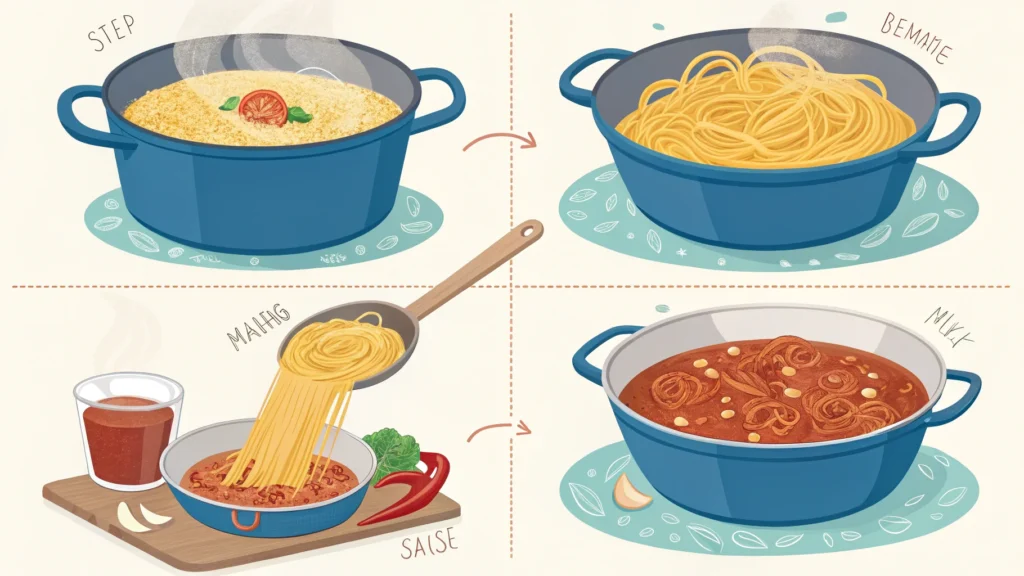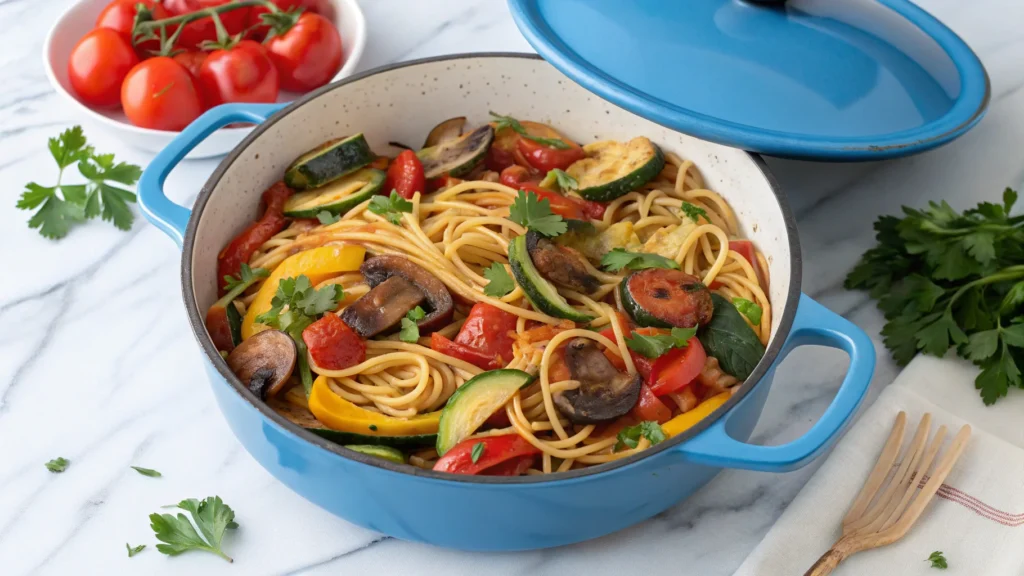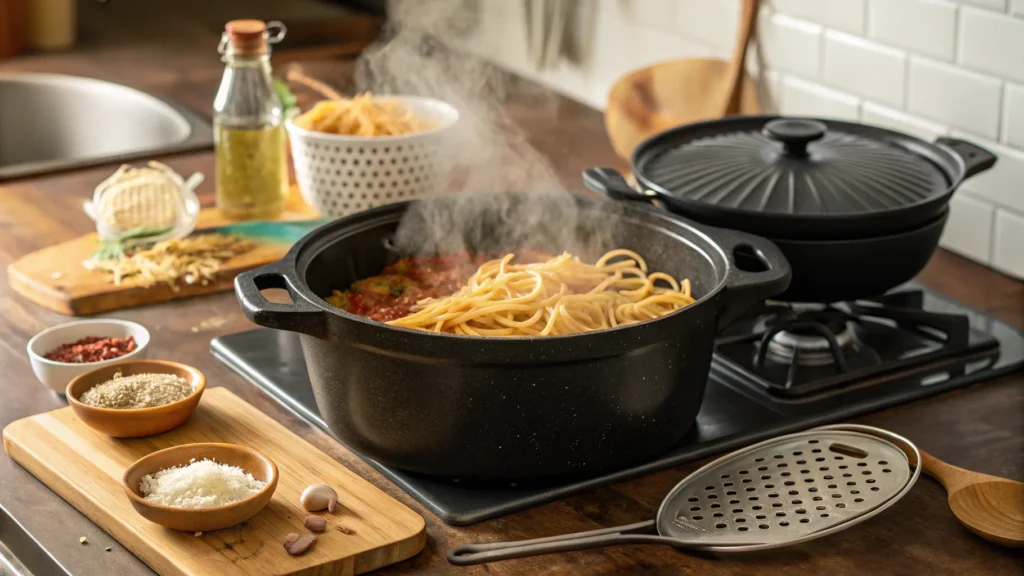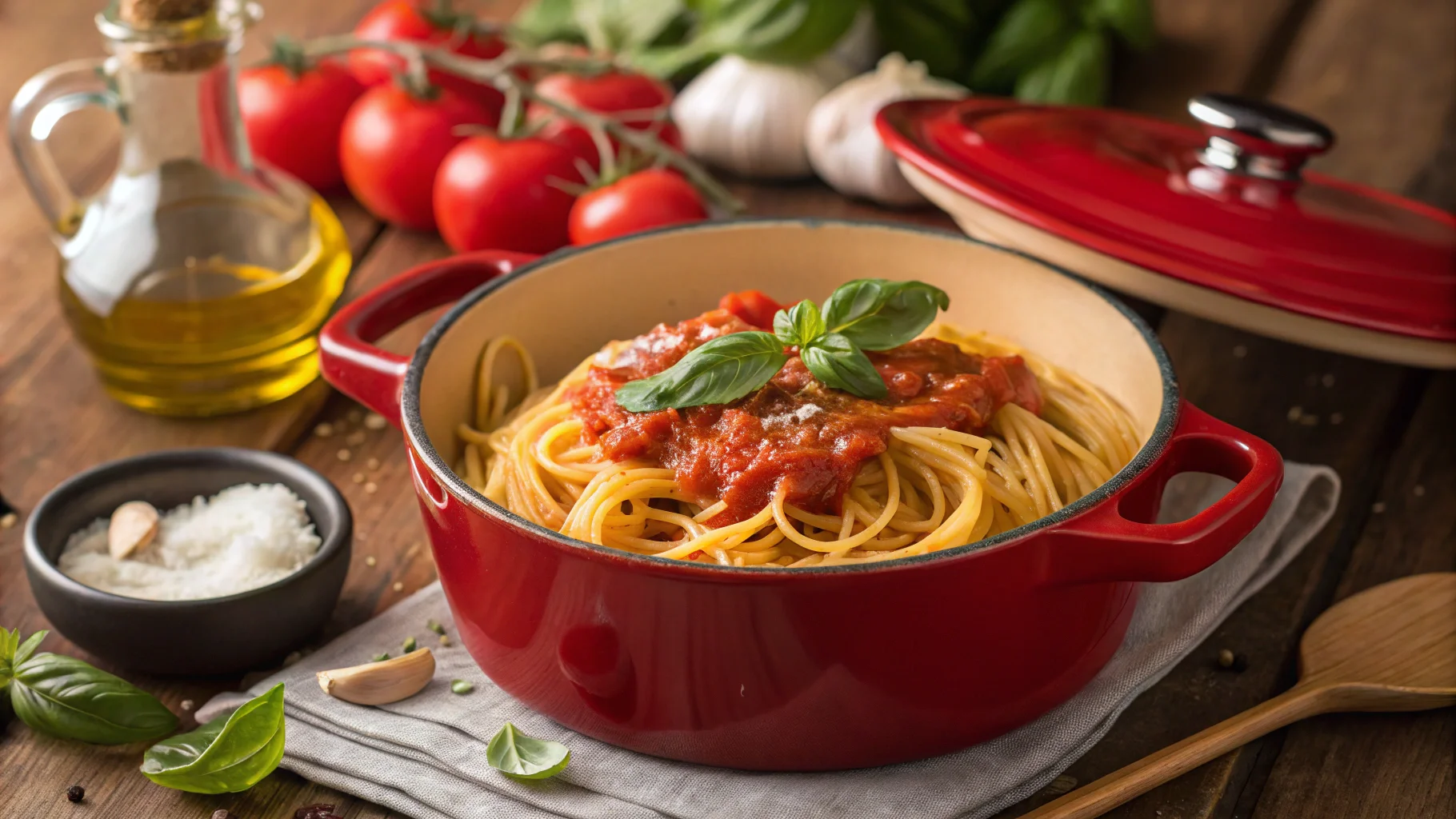Cooking spaghetti can feel routine, but when you introduce a Dutch oven into the process, you elevate a simple dish into something extraordinary. This versatile piece of cookware isn’t just for slow-cooked stews or artisan bread; it’s perfect for spaghetti too! In this article, we’ll explore the benefits of using a Dutch oven for spaghetti, share step-by-step instructions, and highlight recipes, tips, and tricks to make your spaghetti nights easier and tastier. Whether you’re cooking for a crowd or just yourself, this guide has got you covered. Let’s dive in!
Table of contents
- What Is a Dutch Oven and Its Uses?
- Why Choose a Dutch Oven for Spaghetti?
- Cooking Spaghetti in a Dutch Oven: Step-by-Step Guide
- Dutch Oven Spaghetti Recipes for Every Occasion
- Benefits of Cooking Spaghetti in a Dutch Oven
- Tips and Tricks for Perfect Dutch Oven Spaghetti
- Common Questions About Using a Dutch Oven for Spaghetti
- FAQs from the Web
- Conclusion: Is a Dutch Oven Perfect for Spaghetti?
What Is a Dutch Oven and Its Uses?
What Is a Dutch Oven?
A Dutch oven is a heavy-duty pot made from cast iron, typically coated with enamel. It’s renowned for its ability to retain and distribute heat evenly, making it an ideal tool for a variety of cooking techniques like baking, braising, frying, and slow cooking. This cookware staple has been used for centuries and is beloved for its versatility and durability.
Traditional Uses of a Dutch Oven in Cooking
Dutch ovens are most commonly associated with hearty, slow-cooked meals like stews, soups, and casseroles. Thanks to their thick walls and tight-fitting lids, they’re excellent for locking in moisture and flavor. They’re also perfect for bread baking, as they mimic the effects of a professional steam oven, resulting in a crispy crust and soft interior.
Advantages of Using a Dutch Oven for Pasta Dishes
Why should you consider using a Dutch oven for spaghetti? First, it provides superior heat retention, ensuring that your water boils quickly and stays hot. Second, you can cook your pasta and sauce in a single pot, streamlining the process and reducing cleanup. Lastly, the spacious interior allows spaghetti to cook evenly without clumping or sticking, a common challenge with smaller pots.
By now, you can see why Dutch ovens have earned their place in kitchens worldwide. And yes, they’re perfect for spaghetti!
Why Choose a Dutch Oven for Spaghetti?
Heat Distribution and Retention Benefits
When it comes to cooking pasta, consistent heat is key. Dutch ovens are made from thick cast iron, which excels at evenly distributing heat. This means you won’t encounter hot spots or areas where the water boils unevenly. Plus, once the water reaches a rolling boil, a Dutch oven retains heat like a champ, ensuring your spaghetti cooks perfectly every time. If you’ve been wondering, the answer is a resounding yes—thanks to its exceptional heat management.
One-Pot Cooking Convenience
A major perk of using a Dutch oven for spaghetti is its ability to simplify your cooking process. With its generous size, you can prepare both the pasta and the sauce in a single pot. Imagine this: no juggling between multiple pans or dealing with extra dishes. Just cook the pasta, drain it, and then whip up your sauce right in the same pot. This one-pot wonder makes meal prep a breeze, especially for busy weeknights.
Minimizing Cleanup: Dutch Oven as a Multi-Use Tool
Nobody loves doing dishes, right? A Dutch oven reduces your cleanup load significantly. Since you can cook your spaghetti and sauce in the same pot, there’s no need to scrub multiple pans. Moreover, most Dutch ovens are coated with enamel, which prevents sticking and makes cleaning as simple as a quick rinse. It’s another reason why this versatile cookware is perfect for spaghetti.

Cooking Spaghetti in a Dutch Oven: Step-by-Step Guide
Preparation: Choosing Ingredients and Tools
Before you start cooking, gather all your ingredients. You’ll need dry spaghetti, water, salt, olive oil, and your choice of sauce ingredients. For tools, your trusty Dutch oven takes center stage, along with a wooden spoon and a strainer. Choosing the right size Dutch oven is important—a 5- to 6-quart pot works well for most spaghetti recipes.
Cooking Spaghetti in a Dutch Oven: Step-by-Step Process
- Fill your Dutch oven with water, leaving enough room to prevent boiling over. Add a generous pinch of salt to enhance the pasta’s flavor.
- Bring the water to a rolling boil. Thanks to the Dutch oven’s heat retention, this won’t take long.
- Add the spaghetti, stirring occasionally to prevent it from sticking. Since the pot is spacious, the pasta will cook evenly.
- Once cooked to al dente, drain the pasta and set it aside.
- Return the Dutch oven to the stove and add olive oil, onions, garlic, or any other base ingredients for your sauce. Sauté until fragrant.
- Pour in tomatoes or your preferred sauce ingredients, then simmer until flavors meld together. Finally, toss the spaghetti back into the pot, coating it in the sauce.
Avoiding Common Mistakes While Cooking Pasta in a Dutch Oven
It’s easy to avoid pitfalls when using a Dutch oven for spaghetti. Don’t overfill the pot with water—leave room for stirring and boiling. Additionally, keep an eye on the heat level to prevent burning the sauce during simmering. With these simple tips, your spaghetti will turn out delicious every time.
Dutch Oven Spaghetti Recipes for Every Occasion
Simple Dutch Oven Spaghetti Recipe
One of the easiest ways to make spaghetti is by using your Dutch oven for both cooking and serving. Begin by boiling the pasta directly in the Dutch oven, then drain it. Use the same pot to prepare a simple tomato-based sauce with garlic, onions, and herbs. Toss the spaghetti back into the sauce and let it simmer for a few minutes to soak up the flavors. This method is perfect for a quick and satisfying meal.
Vegetarian Options for Dutch Oven Spaghetti
For a plant-based twist, you can create a vegetarian Dutch oven spaghetti recipe using seasonal vegetables like zucchini, mushrooms, and bell peppers. Add crushed tomatoes, garlic, and Italian seasoning for a robust sauce. As the Dutch oven retains heat so well, it allows the vegetables to cook evenly, enhancing their natural flavors. This recipe is great for meat-free Mondays or when you’re craving something light yet filling.
One-Pot Spaghetti and Sauce Recipes
If you love convenience, try a one-pot spaghetti recipe. Combine uncooked spaghetti, water, crushed tomatoes, olive oil, and seasonings in your Dutch oven. As everything cooks together, the starch from the pasta thickens the sauce, creating a creamy, restaurant-quality dish. It’s a time-saver and a crowd-pleaser!
For more delicious recipes, check out this detailed guide on cooking spaghetti and meatballs in a Dutch oven.

Benefits of Cooking Spaghetti in a Dutch Oven
Enhanced Flavor with Slow Cooking
One of the standout benefits of using a Dutch oven is how it enhances the flavor of your spaghetti. The thick walls and tight-fitting lid create a mini oven-like effect, locking in moisture and allowing flavors to develop slowly. This makes it ideal for simmering sauces right after boiling your pasta, letting all the ingredients meld beautifully.
Energy Efficiency of Dutch Ovens
Another major perk of cooking spaghetti in a Dutch oven is its energy efficiency. Its heat retention properties mean you can cook at a lower temperature for shorter periods, saving both energy and time. Plus, its versatility means you don’t need multiple pots or pans, streamlining your cooking process.
Can you use a Dutch oven for spaghetti? Without a doubt, it’s one of the best ways to bring out the natural flavors of the dish while simplifying your kitchen routine.
For tips on keeping pasta from sticking in your Dutch oven, visit this helpful guide.
Tips and Tricks for Perfect Dutch Oven Spaghetti
Choosing the Right Size and Material
Picking the right Dutch oven is crucial for perfect spaghetti. Opt for a pot that holds at least 5 to 6 quarts, as this provides ample space for water, pasta, and sauce without spilling over. Enamel-coated Dutch ovens are ideal since they prevent sticking and are easier to clean. While traditional cast iron works too, the enamel coating adds convenience for everyday use.
Maintaining the Right Liquid-to-Pasta Ratio
One common question is, “Can you use a Dutch oven for spaghetti without it clumping or overcooking?” The answer lies in the liquid-to-pasta ratio. For every pound of pasta, use 4 to 5 quarts of water to ensure even cooking. If you’re making a one-pot dish, use just enough liquid to cook the spaghetti while leaving room for the sauce to thicken.
How to Avoid Sticking and Burning
To prevent your spaghetti from sticking, always stir the pasta during the first few minutes of cooking. When making sauces, keep the heat low to medium to avoid burning. Dutch ovens are excellent at retaining heat, so you won’t need high temperatures to get the job done. A little olive oil in the water can also help keep the pasta separate and smooth.
Common Questions About Using a Dutch Oven for Spaghetti
Can You Boil Pasta in a Dutch Oven?
Yes, you absolutely can! Boiling pasta in a Dutch oven is straightforward, thanks to its wide base and excellent heat retention. The pot allows water to boil quickly and evenly, cooking spaghetti perfectly al dente. Whether you’re making a large batch or a small one, a Dutch oven is up to the task.
Can You Use a Dutch Oven on an Electric or Gas Stove?
Of course! Dutch ovens are designed to work on almost all heat sources, including gas and electric stoves. Their sturdy construction makes them adaptable to various cooking surfaces. Just remember to lift (not drag) the pot to avoid scratching glass-top stoves.
How Do You Clean a Dutch Oven After Cooking Pasta?
Cleaning a Dutch oven is a breeze, especially if it has an enamel coating. After cooking, let the pot cool down to avoid thermal shock. Then, wash it with warm water, mild soap, and a soft sponge. Avoid using abrasive scrubbers, as they can damage the surface. For stubborn residue, soaking the pot for a few minutes usually does the trick.
These tips and answers show why using a Dutch oven for spaghetti is not only practical but also incredibly versatile!
FAQs from the Web
Can You Cook Spaghetti Sauce Directly in the Dutch Oven?
Yes, and it’s one of the best uses of a Dutch oven! After boiling your spaghetti, simply drain it and use the same pot to make the sauce. The even heat distribution ensures that the sauce simmers perfectly without sticking or burning. Whether you’re making marinara, alfredo, or a rich meat sauce, the Dutch oven locks in flavors beautifully. So, can you use a Dutch oven for spaghetti sauce? Absolutely, and it simplifies your cleanup too!
What Type of Dutch Oven Is Best for Spaghetti Dishes?
When it comes to spaghetti, an enamel-coated cast iron Dutch oven is ideal. It’s non-stick, easy to clean, and doesn’t react with acidic ingredients like tomatoes. A 5- or 6-quart size works well for most recipes, giving you enough room to cook pasta and prepare sauce all in one pot.
Does Cooking Spaghetti in a Dutch Oven Save Time?
Yes! The Dutch oven’s excellent heat retention means water boils faster, and the pasta cooks more evenly. Additionally, since you can prepare both the spaghetti and sauce in the same pot, it eliminates the need to juggle multiple pans. This efficiency not only saves time but also reduces stress in the kitchen.

Conclusion: Is a Dutch Oven Perfect for Spaghetti?
Recap of the Dutch Oven’s Versatility
In the end, the Dutch oven proves itself as a kitchen powerhouse. Its ability to boil pasta, simmer sauces, and even serve as a one-pot cooking tool makes it an excellent choice for spaghetti dishes. By retaining heat and locking in flavor, it turns an everyday meal into something truly special.
Final Thoughts on Making Spaghetti in a Dutch Oven
So, can you use a Dutch oven for this recipes Without a doubt, yes! Its versatility, ease of use, and time-saving benefits make it a must-have for pasta lovers. Whether you’re cooking a simple dinner for yourself or preparing a hearty meal for family and friends, the Dutch oven has you covered.
For inspiration, try this easy Spaghetti and Meatballs in a Dutch Oven recipe, or check out tips on keeping pasta from sticking in your Dutch oven. If you’re exploring other uses for Dutch ovens, read about whether food cooks faster in a Dutch oven. These resources will help you master this versatile tool in no time!

